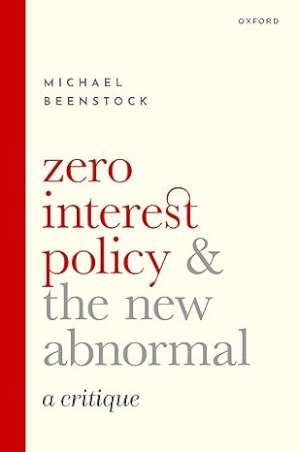24 November 2023
Zero Interest Policy and the New Abnormal: a Critique
Michael Beenstock
2022, Oxford University Press, 388 pages,
ISBN 9780192849663
Reviewer: Kate Barker, Universities Superannuation Scheme

As the title suggests, this is a strongly-argued criticism of the policy stance adopted in many developed market economies since the Global Financial Crisis (GFC). In sum, the argument is that the combination of zero interest rate policies (ZIP) and rising debt-to-GDP ratios adopted up to 2022 posed existential risk. This depressed economies, rather than stimulating them, as businesses and populations became fearful of the future.
The tone of the book can be summed up in this quote: ‘Future economic historians will no doubt be fascinated and puzzled by the New Abnormal. It will be regarded as a unique aberration in economic history.’
The first step in Beenstock’s argument is that there has been an error in understanding the natural rate of interest. Central bankers believed, because output and inflation were on target at zero interest rates, that zero is the natural rate. However, because at zero interest rates we are effectively in a liquidity trap (monetary growth ceases to affect inflation) this is misleading. The Wicksellian natural rate is properly the return on fixed capital assets. His estimates of the natural rate across many large countries suggests it is very much higher than zero.
If this was such a big error – how did it become pervasive across so many countries? Beenstock explains that by reference to concerns about exchange rates. He also blames ‘post-modern macroeconomics’ – the move to DGSE models and away from the struggle for models which fit the data. Although he deplores the failure of the fiscal authorities to control their deficits, the main thrust of the critique is against the behaviour of central banks.
A key part of this critique revolves around ‘kinetic’ inflation – which is defined as the potential inflation induced by ZIP. If at zero interest rates the demand for money is infinitely elastic, we should expect this inflation to be released when interest rates are increased. The estimate for the US of the scale of this inflation is very large, though it is argued that it would be mitigated by the reversal of Quantitative Easing. On this basis, it is argued that central bankers fell into error – the rate of return on capital did not follow the cost of capital down, and that should have indicated that all was not well.
Beenstock regards Japan as a special case for study, and looks at the failure of the policymakers there to undertake the structural reforms needed to move into a period when the post-war ‘economic miracle’ had run out of steam. He attributes this to cultural factors, in particular the issue of ‘face-saving.’
Moving on to the consequences of this policy error, there is a speculation (Beenstock admits this is unproven) that the long period of ZIP in Japan was also associated with a decline in fertility, as concern about the future discouraged people from having children. Less speculative is his commentary about pensions – where funded pensions are forced to have either lower returns or take on more investment risk. In addition, future generations also face the burden of public debt.
Turning to Covid, he argues that governments behaved abnormally in taking a large economic cost (higher fiscal deficits) in order to save lives – so attributing a value to life much higher than is normally done. This is demonstrated by a counterfactual for Israel. I parted company with the author here. Governments made these decisions in times of very high uncertainty about the course of the pandemic and the progress of vaccines. Nor am I sure economists are the best at running disease counterfactuals.
The final chapter discusses the end of the ‘New Abnormal’ and the risk that for some countries there will not be orderly exits, with the possibility of spiralling government debt-to-GDP ratios. He calls for central banks to act early by communicating there is a need to raise interest rates – and then doing so. Further, it is suggested that the restoration of ‘normal’ interest rates will actually boost business investment.
The timing of this publication leads to a quick paragraph at the end acknowledging that ZIP was ending in early 2022. With the luxury of writing eighteen months later, how are Beenstock’s fears playing out? Well, inflation has certainly risen sharply, and globally it cannot all be attributed to energy prices. But the huge rush of ‘kinetic’ inflation is not as yet apparent.
This is a thought-provoking book. However, in some parts I felt the fears were over-played – the estimate of kinetic inflation seems implausibly high, and the extensions to fertility and comments on the Covid response could have been omitted. On the question of whether central banks should have raised rates in the 2010s – it is always hard to re-run history but possible to have sympathy with the argument. It would, however, have meant changes to central banks models (desirable?) and been a big communication problem. But maybe these challenges should have been tackled.
